Complete Solutions to All Questions of chapter LAWS OF THERMODYNAMICS of Class 11 book with complete answers and questions
| Class 11 | PHYSICS |
| Chapter | LAWS OF THERMODYNAMICS |
| HC VERMA | All Questions |
| Number Of Questions | 64 |
| Academic Year | 2023-24 |
A gas is contained in a vessel fitted with a movable piston. The container is placed on a stove. A total of 100 cal of heat is given to the gas and the gas does 40 J of work in the expansion resulting from heating. Calculate the increase in internal energy in the process.
View Solutioncalculate the work done by a gas as it is taken from the state a to b, b to c and c to a as shown in
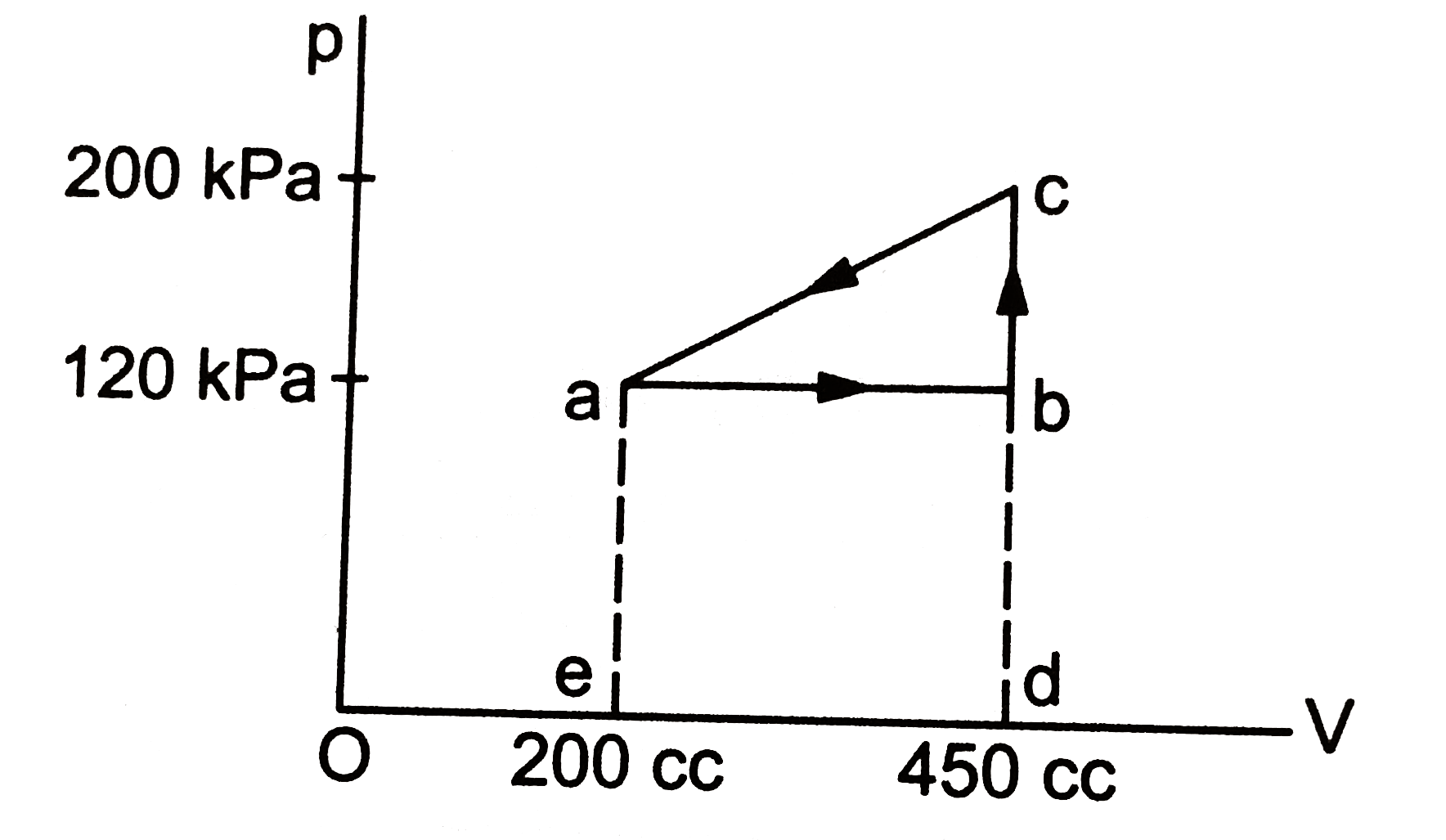
View SolutionA sample of an ideal gas is taken through the cyclic process abca . It absorbs 50 J of heat during the part ab, no heat during bc and rejects 70 J of heat during ca. 40 J of work is done on the gas during the part bc.(a) find the internal energy of the gas at b and c if it is 1500 J at a. (b) calculate the work done by the gas during the part ca.
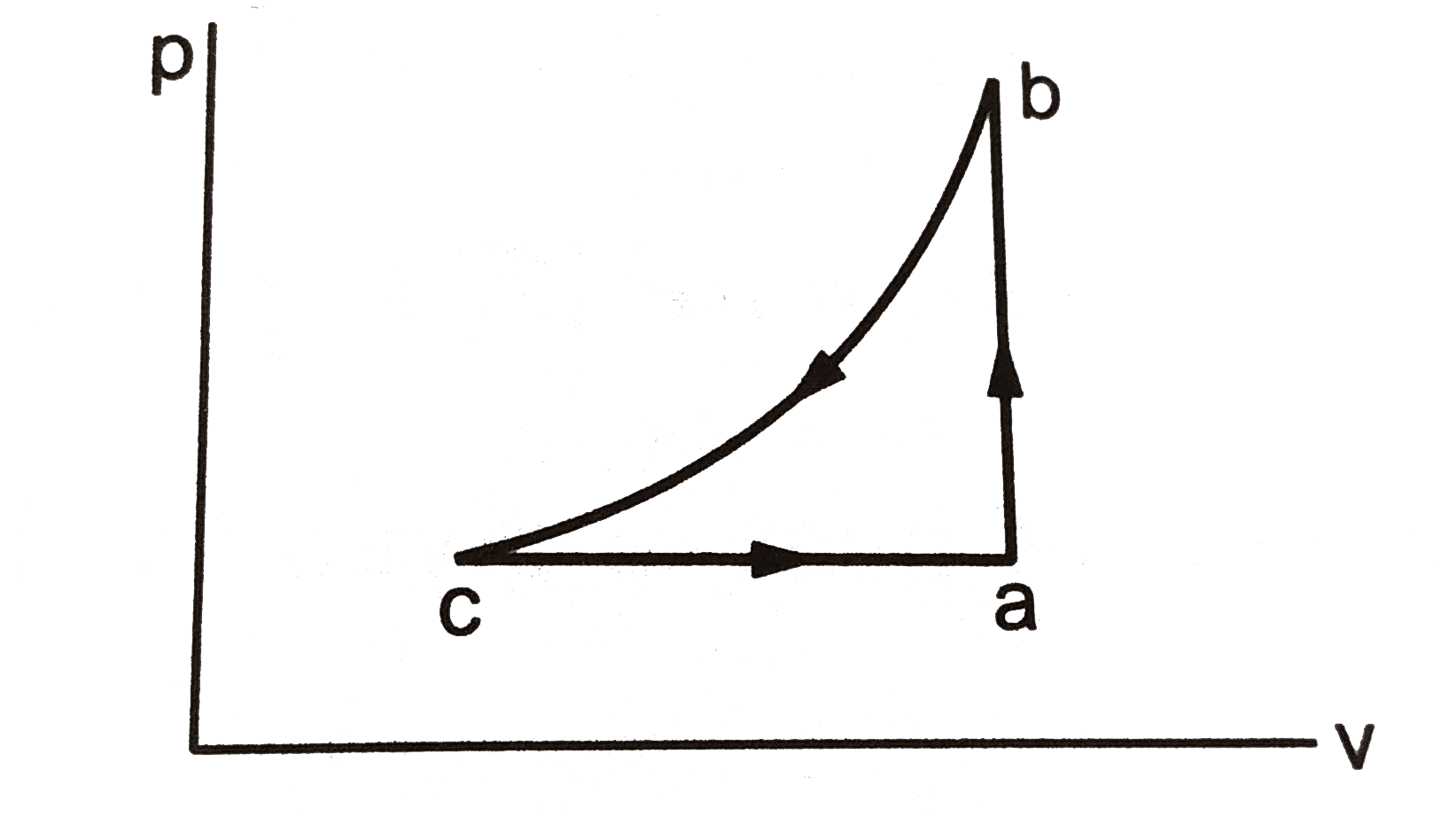
View SolutionA thermodynamic system is taken through the cycle abcda. (a) calculate the work done by the gas during the parts ab, bc, cd and da. (b) find the total heat rejected by the gas during the process.
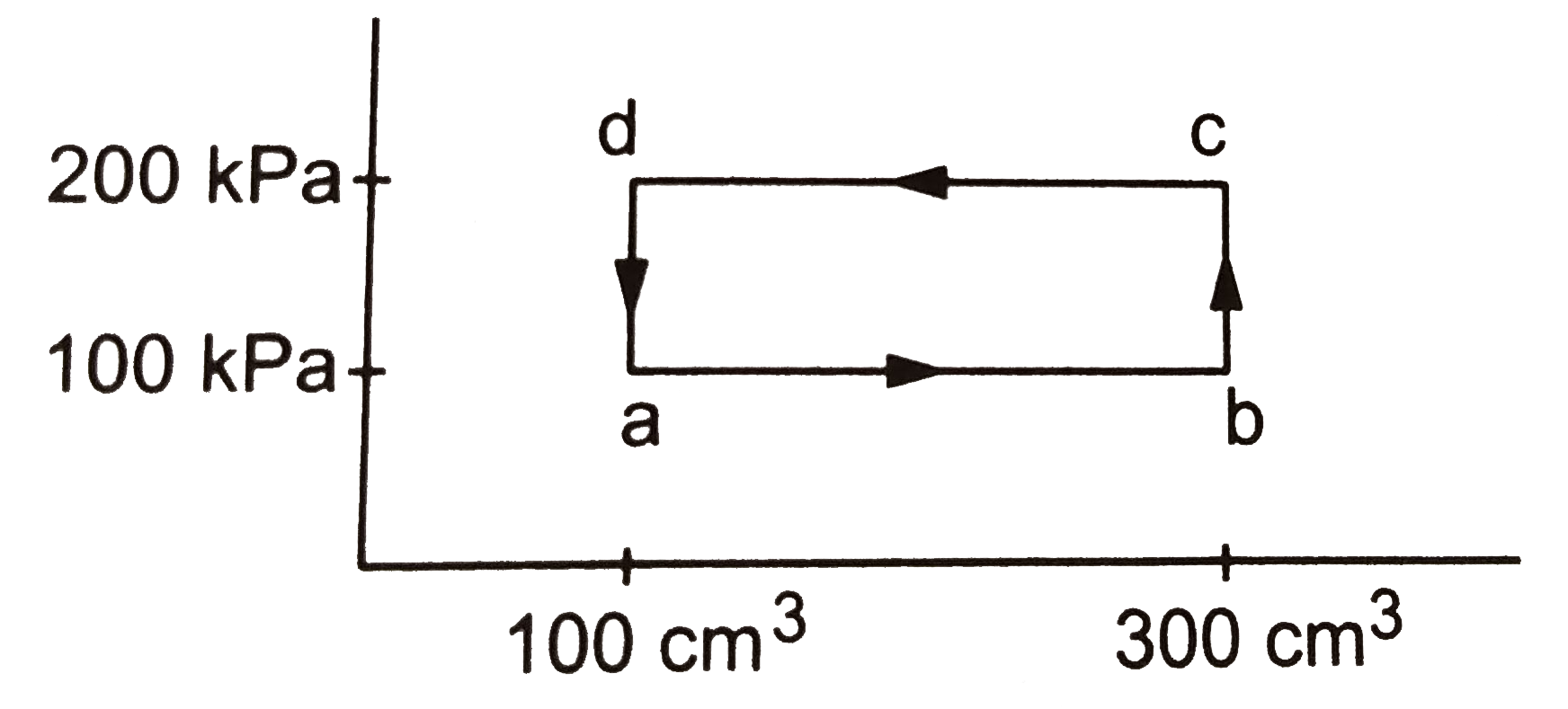
View Solutioncalculate the increase in internal energy of 1 kg of water at `100^(o)C` when it is converted into steam at the same temperature and at 1atm (100 kPa). The density of water and steam are 1000 kg `m^(-3)` and 0.6 kg `m^(-3)` respectively. The latent heat of vaporization of water `=2.25xx10^(6) J kg^(1)`.
View SolutionThe internal energy of a monatomic ideal gas is 1.5 nRT. One mole of helium is kept in a cylinder of cross section `8.5 cm^(2)`. The cylinder is closed by a light frictionless piston. The gas is heated slowly in a process during which a total of 42J heat is given to the gas. if the temperature rise through `2^(o)C`, find the distance moved by the piston. atmoshphere pressure `=100 kPa.
View SolutionA steam engin intakes 100g of steam at `100^(o)C` per minute and cools it down to `20^(o)C`. Calculate the heat rejected by the steam engine per minute. Latent heat of vaporization of steam `=540 cal g^(-1)`.
View SolutionFigure Shows a process ABCA performed on an ideal gas. Find the net heat given to the system during the process.
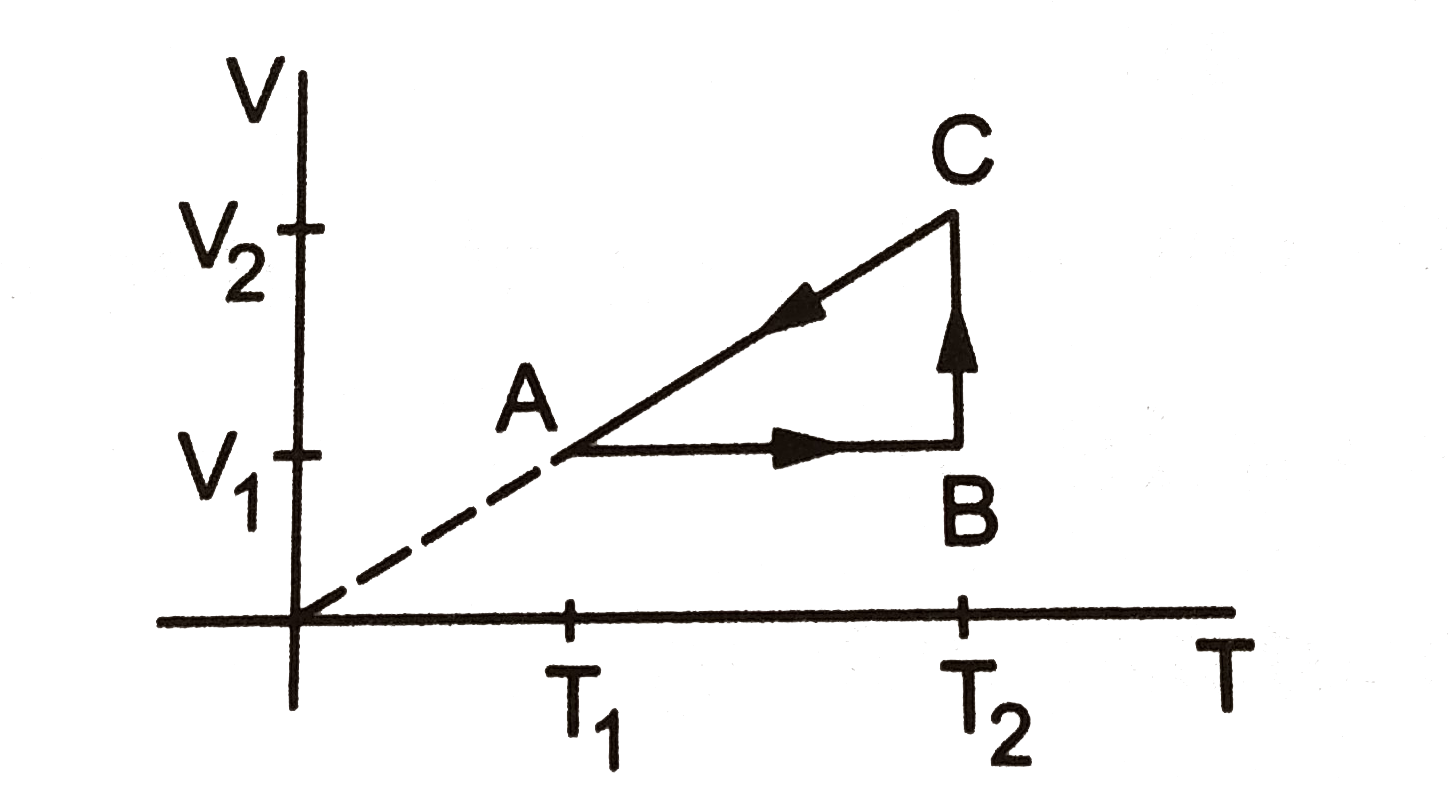
View Solutionconsider the cyclic process ABCA on a sample of 2.0 mol of an ideal gas as shown in the fig. temperature of the gas at A and B are 300 K and 500 k respectively. A total of 1200 J heat is withdrawn from the sample in the process. Find the work done by the gas in part BC. take `R=8.3 JK^(-1) mol^(-1)`
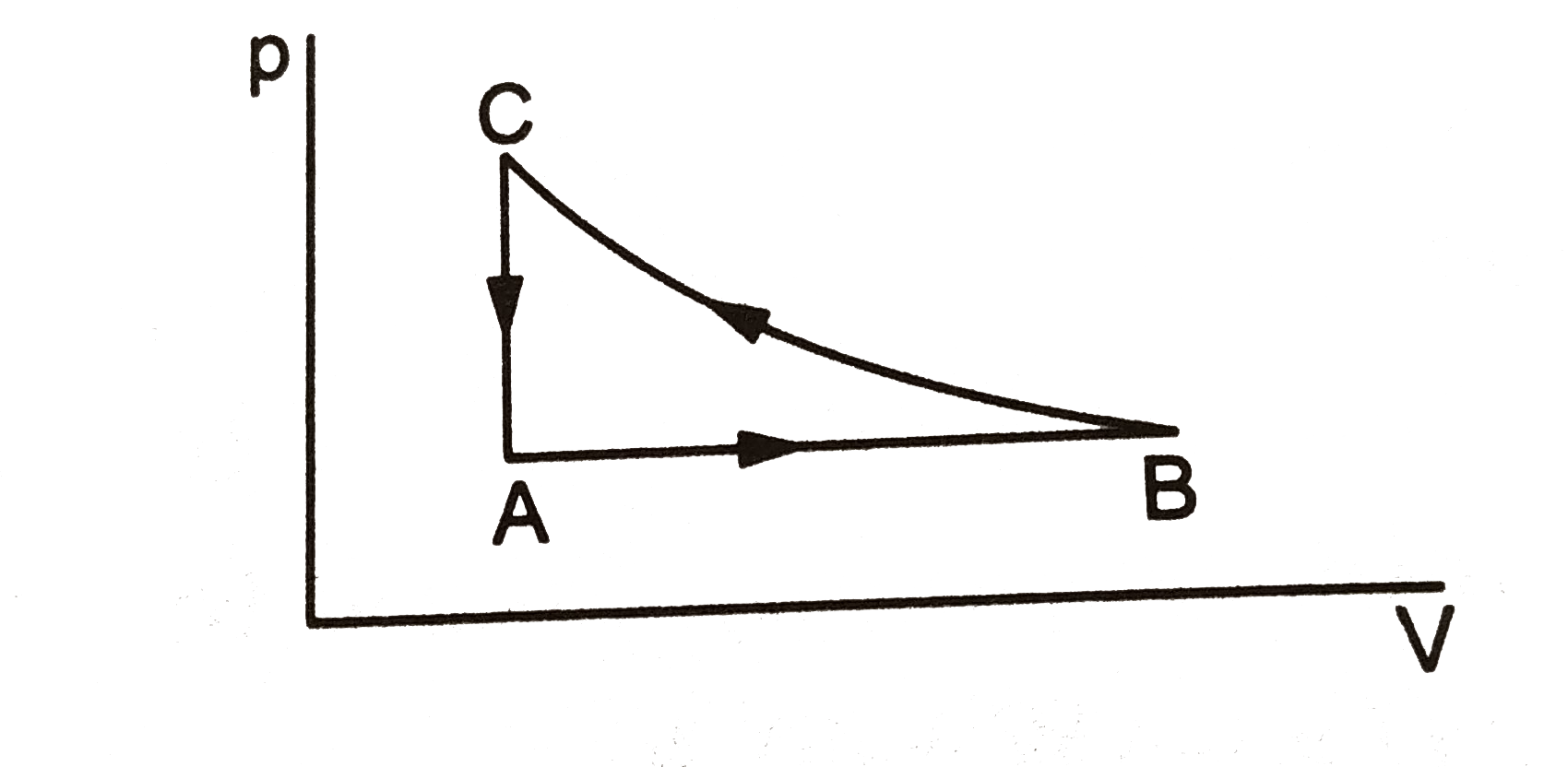
View Solution2.00 mole of a monatomic ideal gas `(U=1.5nRT)` is enclosed in an adiabatic, fixed , vertical cylinder fitted with a smooth, light adiabatic piston. The piston is connected to a vertical spring of spring constant `200 N m^(-1)` as shown in .the area of cross section of the cylinder is `20.0 cm^(2)`. initially, the spring is at its natural length and the temperature of the gas is 300K at its natural length. the atmosphere pressure is 100 kPa. the gas is heated slowly for some time by means of an electric heater so as to move the position up through 10 cm. find (a) the work done by the gas (b) the final temperature of the gas and (c ) the heat supplied by the heater.
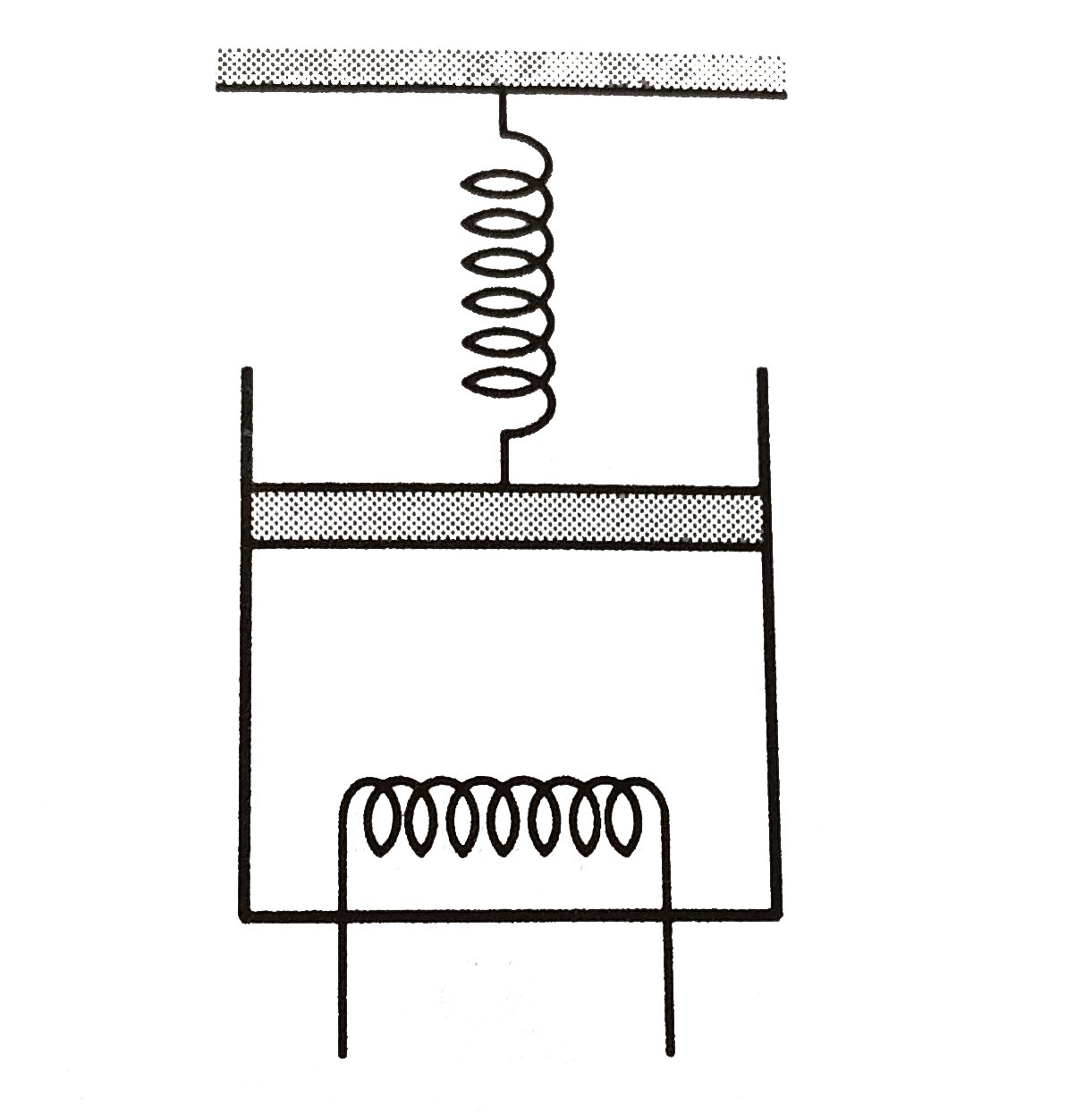
View SolutionA sample of an ideal gas has pressure `p_(0)`, volume `V_(0)` and tempreture `T_(0)`. It is isothermally expanded to twice its oringinal volume.it is then compressed at constant pressure to have the original volume `V_(0)`. Finally, the gas is heated at constant volume to get the original tempreture.(a) show the process in a V-T diagram (b) calculate the heat absorbed in the process.
View SolutionA sample of 100 g water is slowly heated from `27^(o)C` to `87^(o)C`. Calculate the change in the entropy of the water. specific heat capacity of water =4200 j/kg k .
View SolutionA heat engine operates between a cold reservoir at tempreture `T_(2)=300 K` and a hot reservior at tempreture `T_(1)`. It takes 200 J of heat from the hot reservior and delivers 120 J of heat to the cold reservior in a cycle. What could be the minimum tempreture of the hot reservior ?
View SolutionThe first law of theromodynamics is a statement of
View SolutionIf heat is supplied to an ideal gas in an isothermal process.
View SolutionFigure shows two processes `A` and `B` on a system.Let `DeltaQ_(1)` and `DeltaQ_(2)` be the heat given to the system in processes `A` and `B` respectively. Then
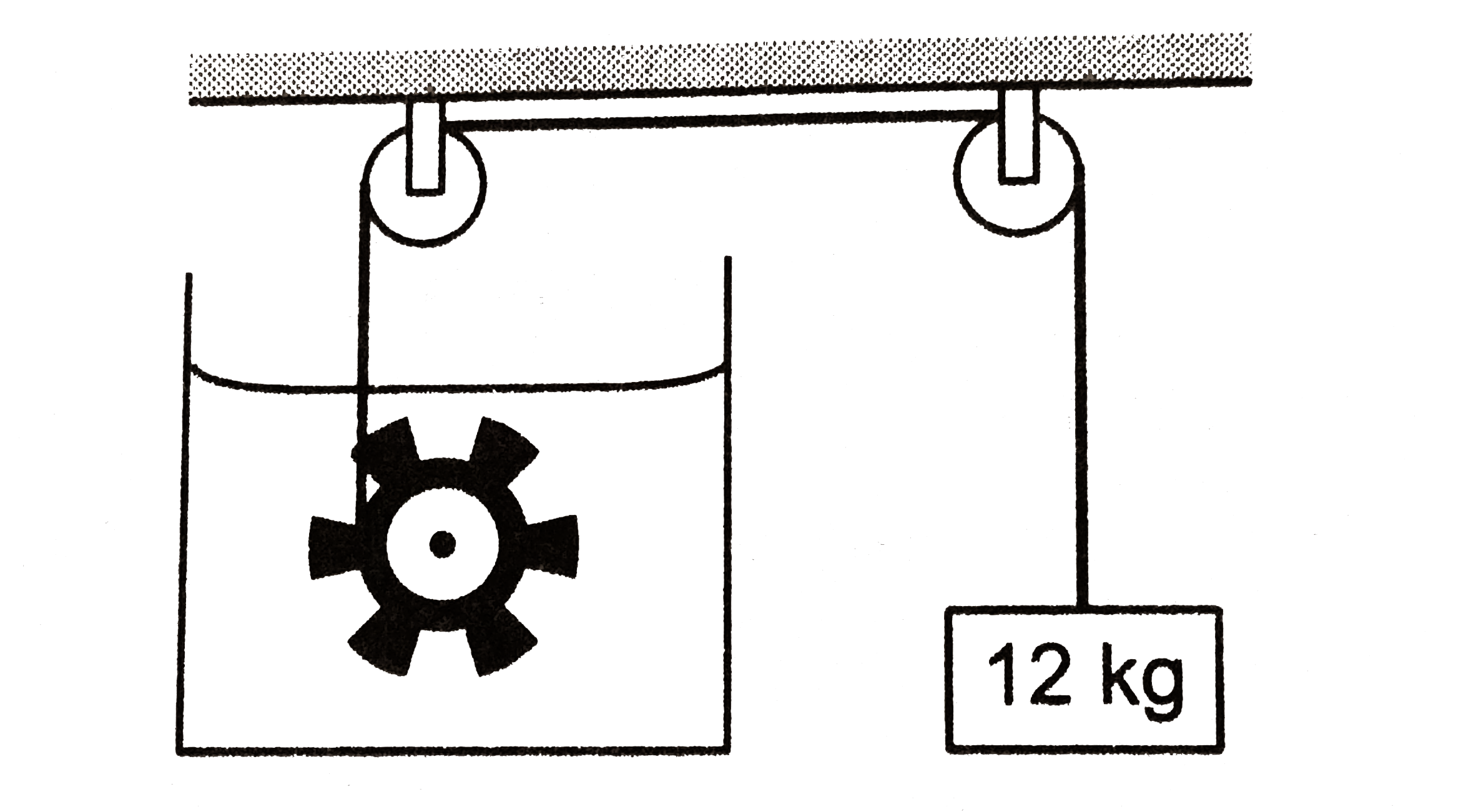
View SolutionRefer to figure. Let `DeltaU_(1)` and `DeltaU_(2)` be the changes in internal energy of the system in the processes A and B. then
View SolutionConsider the process on a system as shown in the figure. During the process, the work done by the system
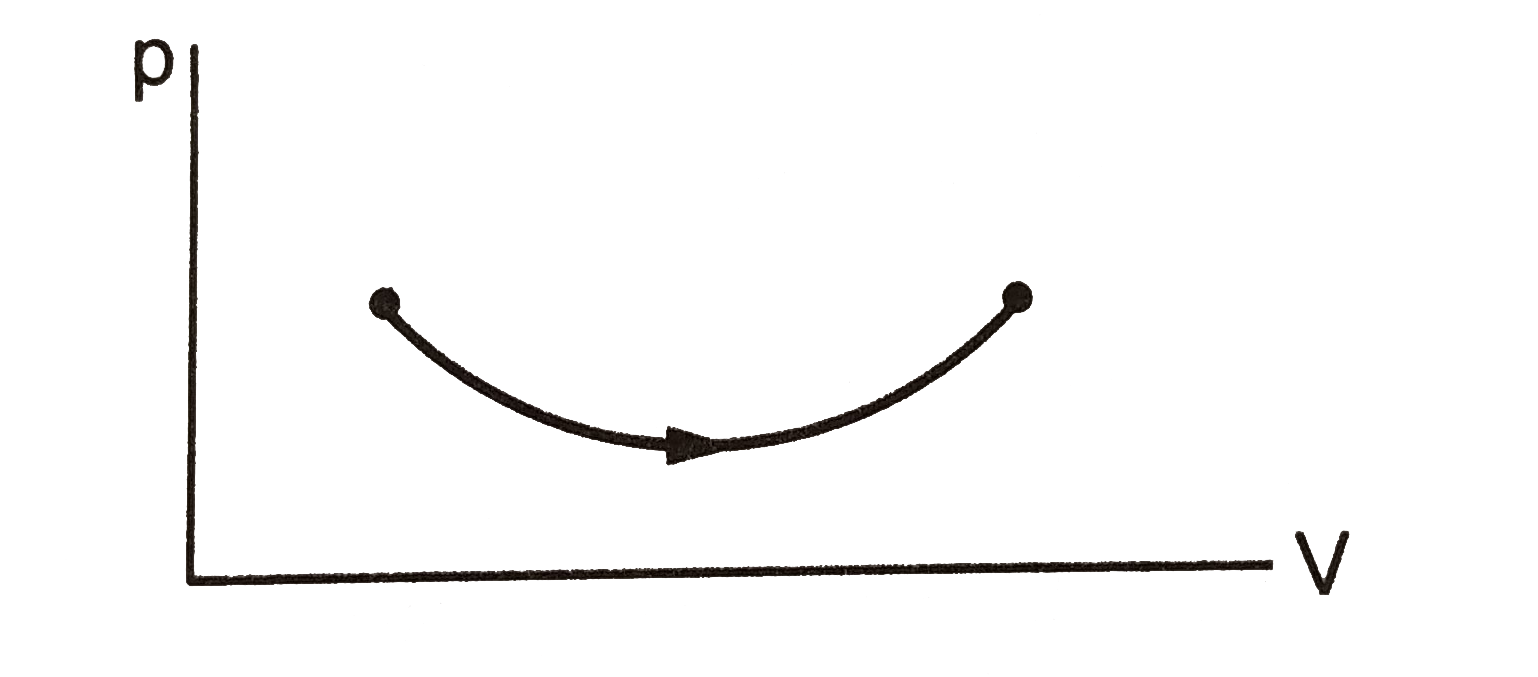
View Solutionconsider the following two statements.
(A) If heat is added to a system, its temperature must increase.
(b) if positive work is done by a system in a thermodynamic process, its volume must increase.
View SolutionAn ideal gas goes from the state i to the state `int` as shown in .the work done by the gas during the process
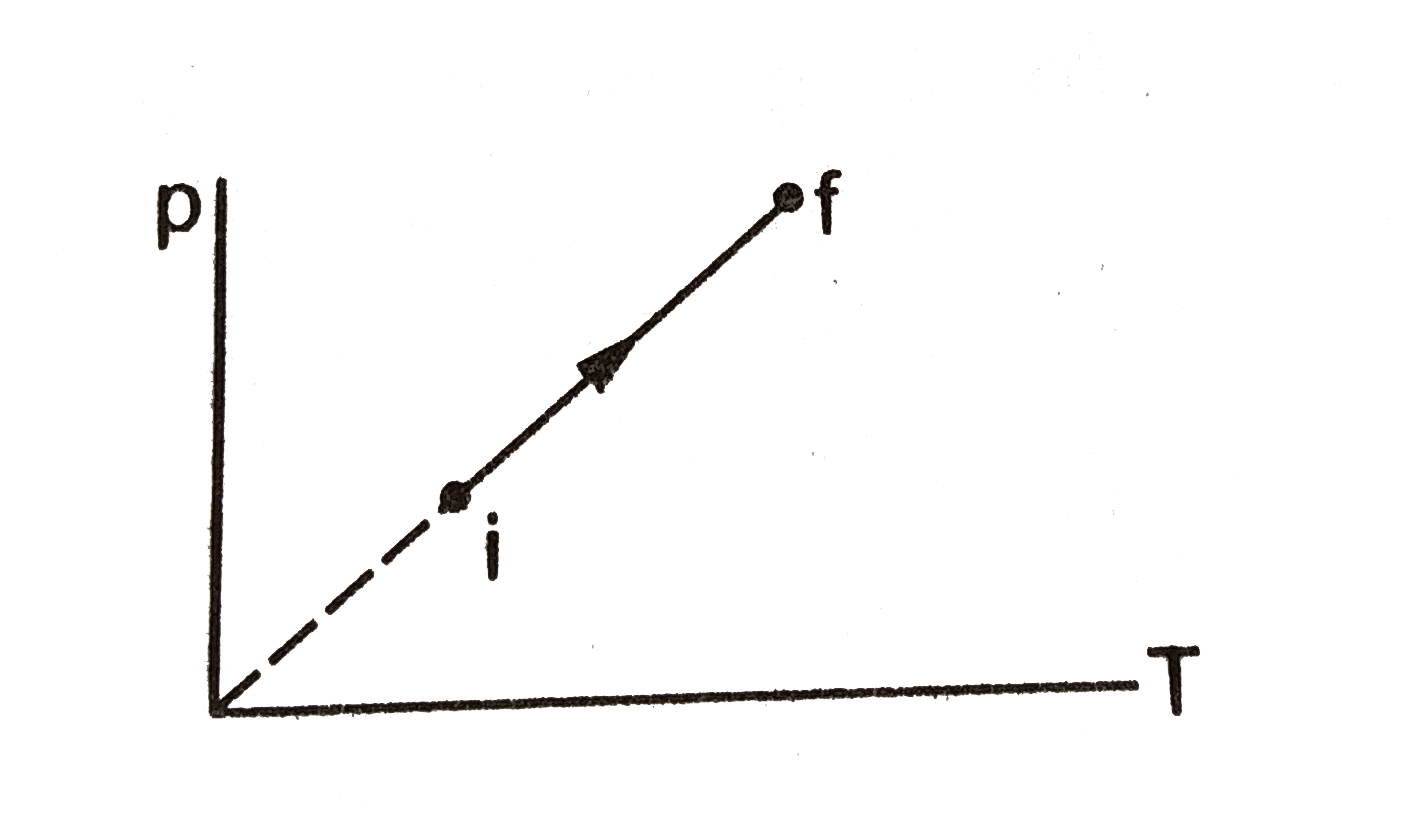
View Solutionconsider two processes on a system as shown in fig
the volumes in the initial stage are the same in the two processes and the volume in the final stage are also the same.Let `DeltaW_(1) and DeltaW_(2)` be the work done by the system in the processes A and B respectively.
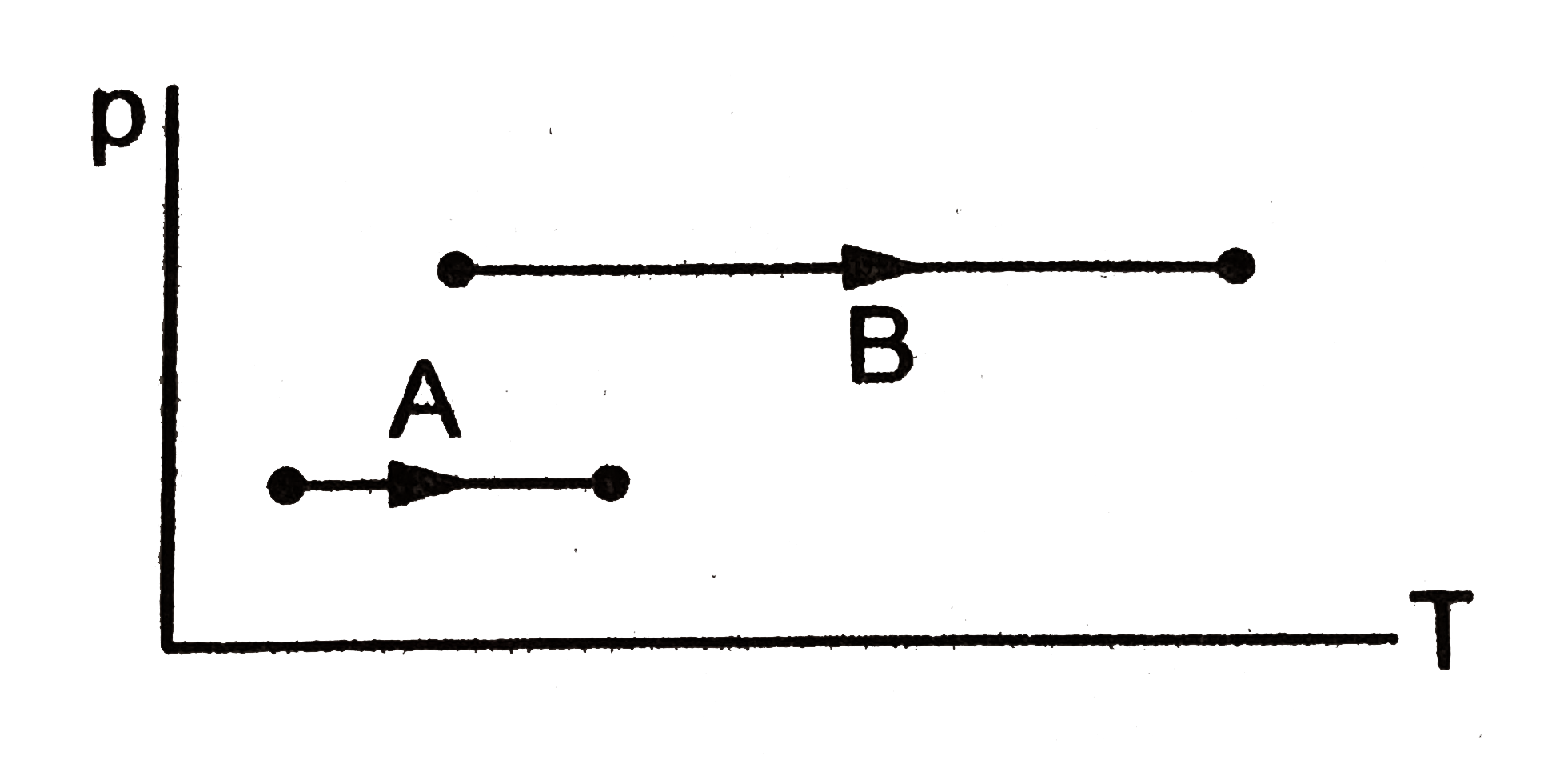
View SolutionA gas is contained in a metallic cylinder fitted with a piston.the piston is suddenly moved in to compress the gas and is maintained at this position. As time passes the pressure of the gas in the cylinder
View SolutionThe pressure p and volume V of an ideal gas both increase in a process.
View SolutionIn a process on a system, the initial pressure and volume are equal to final pressure and volume, then
View SolutionA system can be taken from the initial state `p_(1),V_(1)` to the final state `p_(2,V_(2)` by two different methods, let `DeltaQ and DeltaW` represent the heat given to the system and the work done by the system. Which of the following must be the same in both the method?
View SolutionRefer to figure. Let `DeltaU_(1)` and `DeltaU_(2)` be the changes in internal energy in the system in process `A+B` and `DeltaW` be the net work done by the system in the process `A+B`,
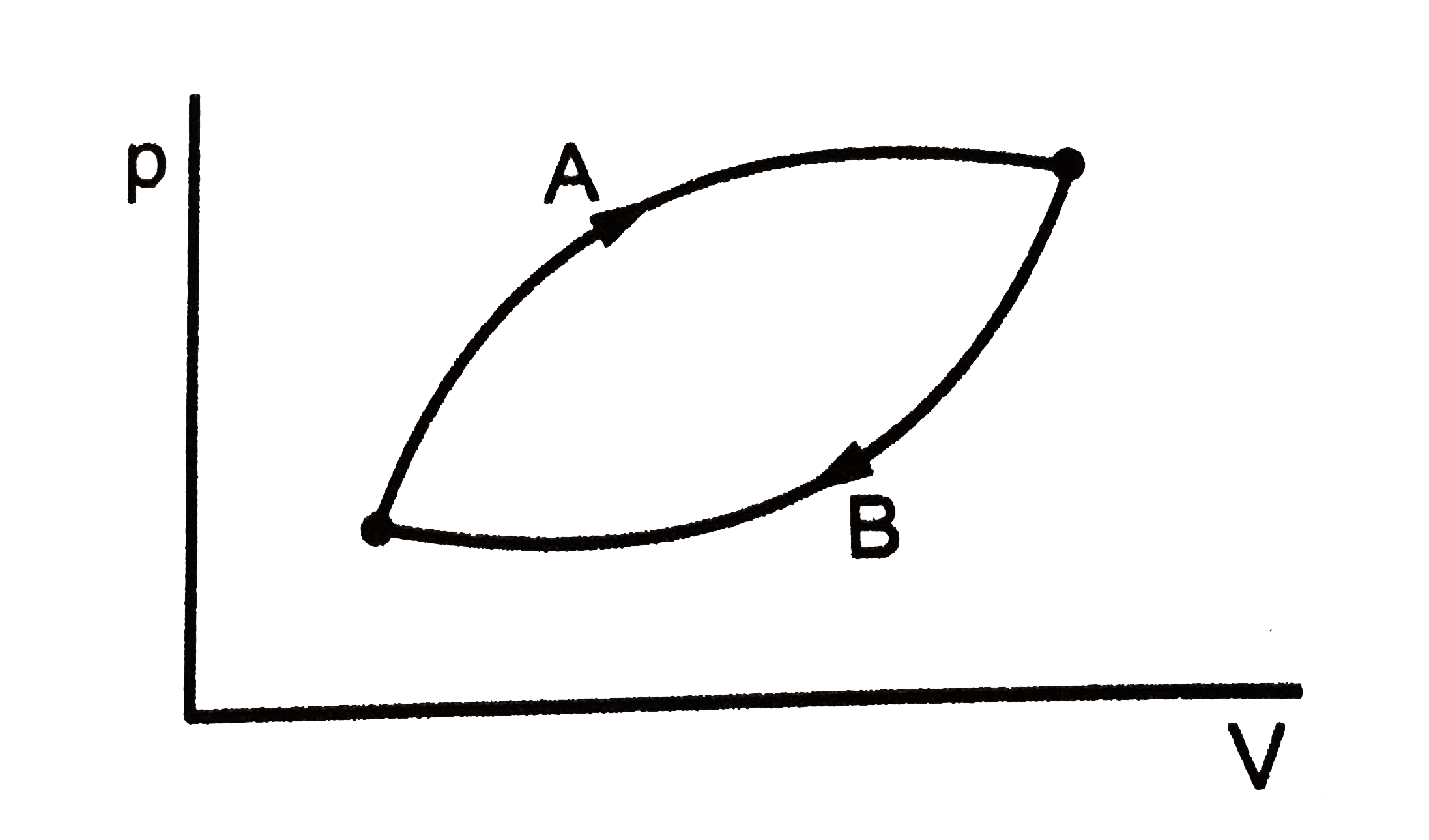
View SolutionThe internal enegy of an ideal gas decreases by the same amount as the work done by the system.
View SolutionA thermally insulated, closed copper vessel contains water at `15^(0)C`. When the vessel is shaken vigorously for 15 minutes, the temprature rises to `17^(0)C`. The mass of the vessel is 100 g and that of the water is 200 g. the specific heat capacities of copper and water are `420 Jkg^(-1) K^(-1)` and `4200 J kg^(-1)K^(-1)` respectively. negalect any thermal expansion.
(a) how much heat is transferred to the liquid-vessel system ?
(b)how much work has been done on this system?
(c ) how much is the increase in internal energy if the system ?
View SolutionShows a peddle wheel couple to a mass of 12 kg through fixed frictionless pulley. The paddle is immersed in a liquid of heat capacity `4200 J K^(-1)` kept in an adiabatic container. Consider a time interval in which the 12 kg block falls slowly through 70cm. (a) how much heat is given to the liquid ? (b) how much work is done on the liquid? (c ) calculate the rise in the temperature of the liquid neglecting the heat capacity of the container and the paddle.

View SolutionA 100 kg block is started with a speed of `2.0 m s^(-1)` on a long, rough belt kept fixed in a horizontal position. The coefficient of kinetic friction between the block and the belt is 0.20. (a) calculate the change in the internal energy of the block-belt system as the block comes to a stop on the belt. (b) consider the situation from a frame of reference moving at `2.0 m s^(-1)` along the initial velocity of the block. as seen from this frame, the block is gently put on a moving belt and in due time the block starts moving with the belt at `2.0 m s^(-1)`, calculate the increase in the kinetic energy of the block as it stops slipping past the belt. (c ) find the work done in this frame by the external force holding the belt.
View Solutioncalculate the change in internal energy of a gas kept in a rigid container when 100 J of heat is supplied to it.
View Solutionthe pressure of a gas change linearly with volume from 10kPa, 200 cc to 50 kPa, 50 cc. (a) calculate the work done by the gas, (b) If no heat is supplied or extracted from the gas, what is the change in the internal energy of the gas ?
View SolutionAn ideal gas is taken from an initial state i to a final state f in such a way that the ratio of the pressure to the absolute temperature remains constant. What will be the work done by the gas ?
View Solutionshows three paths through which a gas can be taken from the state A to the state B. calculate the work done by the gas in each of the three paths.
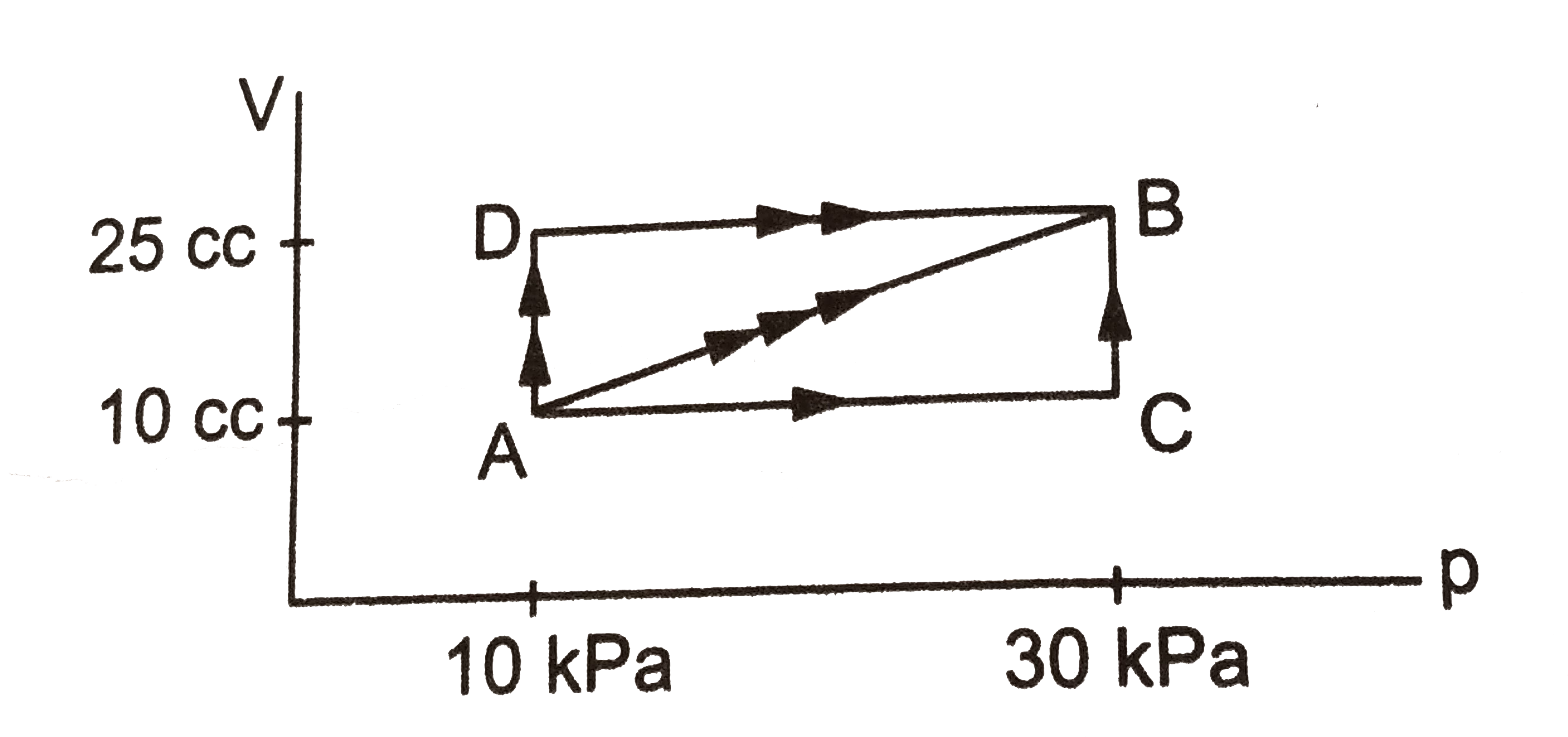
View Solutionwhen a system is taken through the process abc shown in the fig. 80 J of heat is absorbed by the system and 30 J of work is done by it. If the system does 10 J work during the process adc, how much heat flows into it during the process ?
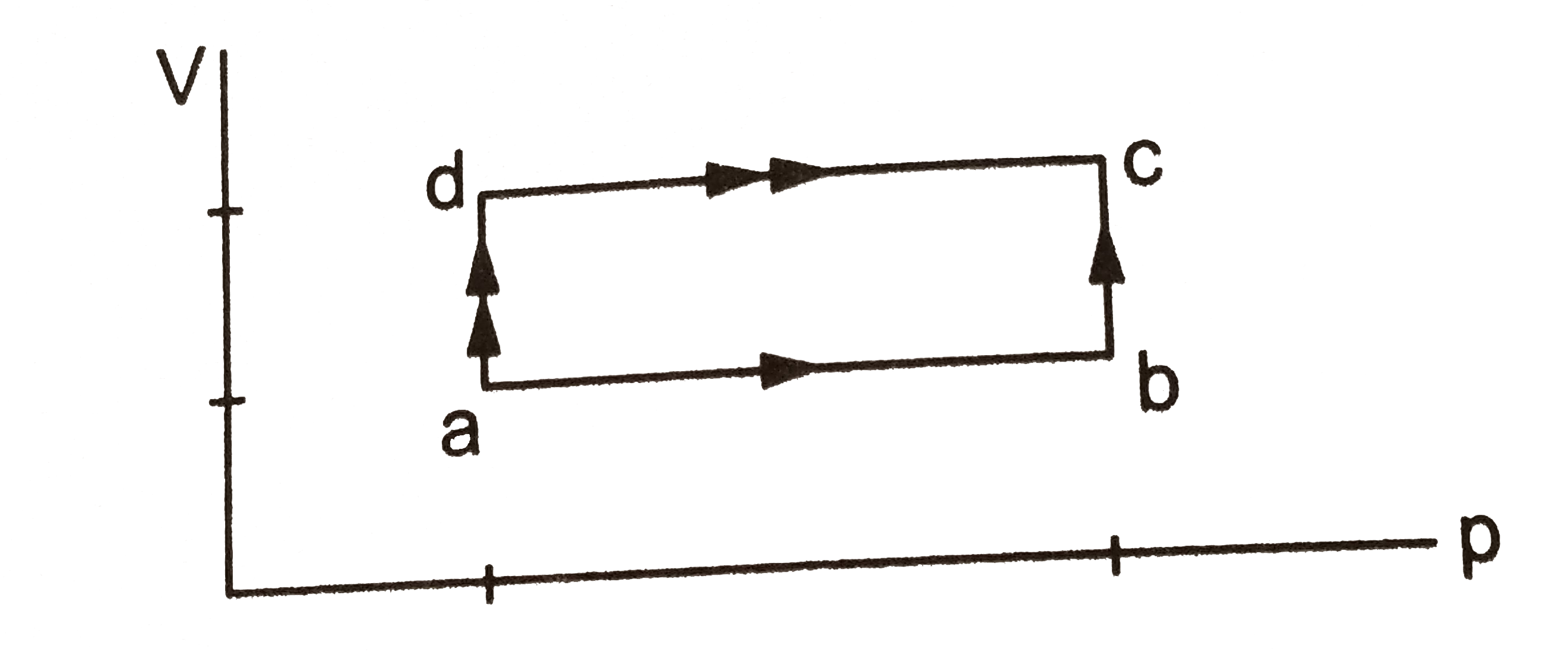
View Solution50 cal of heat should be supplied to take a system from the state A to the state B through the path ABC as shown in fig, Find the quantity of heat to be supplied to take it from A to B via ADB.
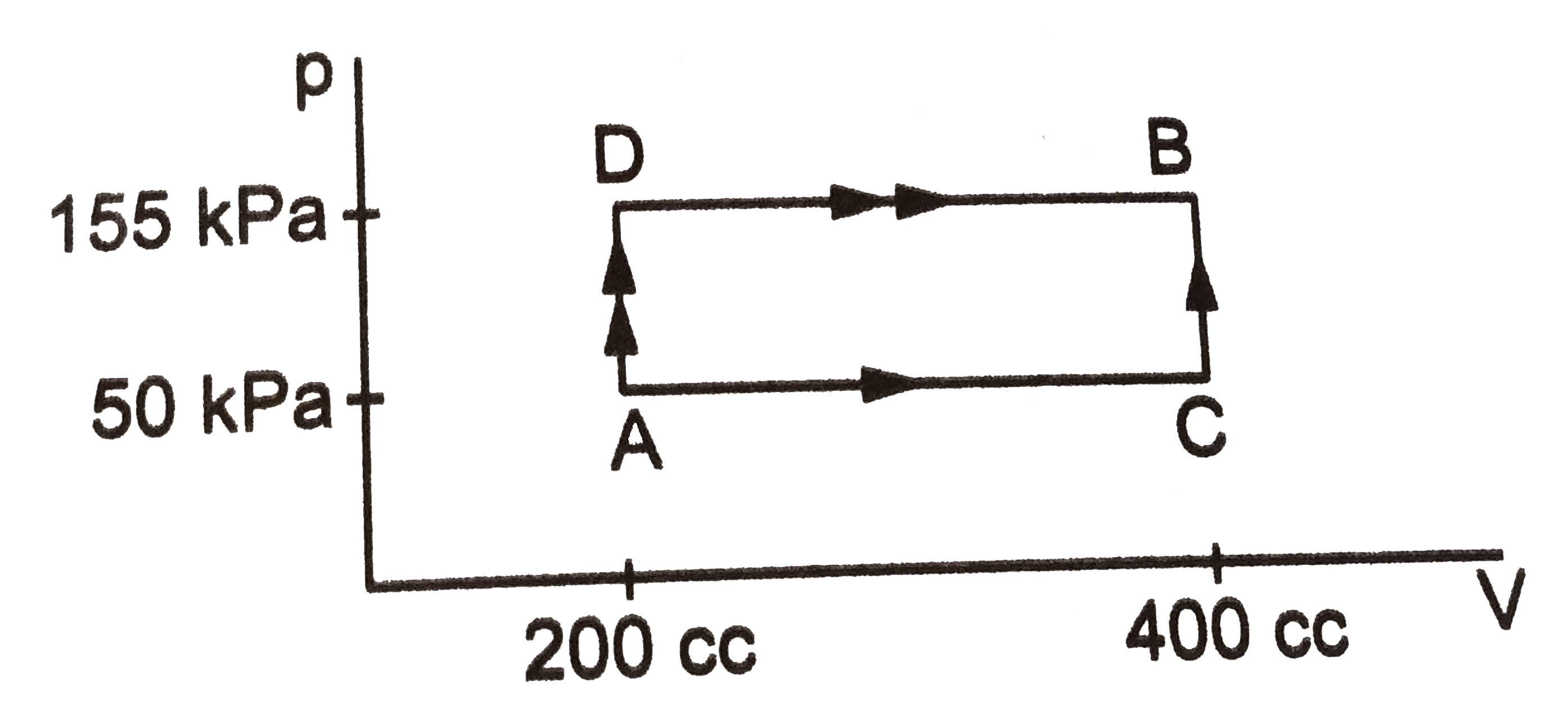
View Solutioncalculate the heat absorbed by a system in going through the cyclic process shown in ,
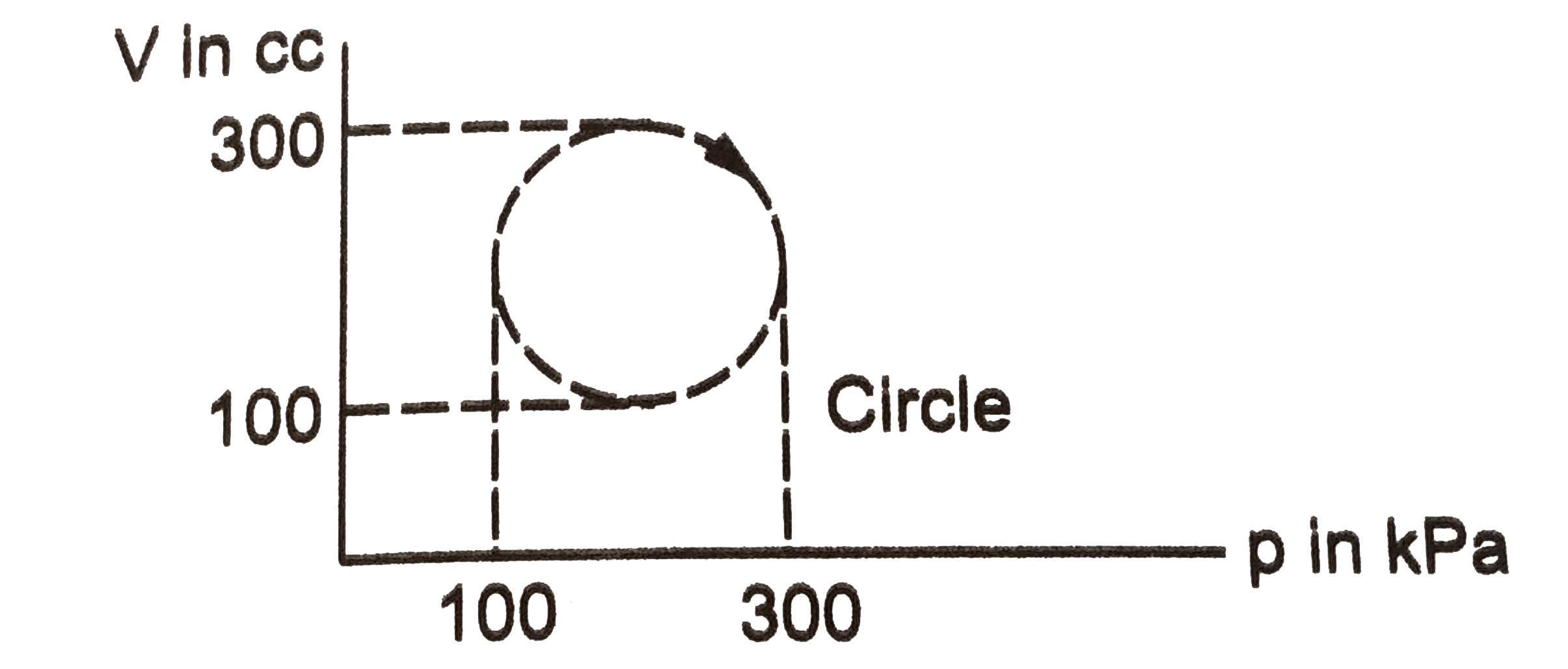
View SolutionA gas is taken through a cyclic process ABCA as shown in, if 2.4 cal of heat is given in the process, what is the value of J ?
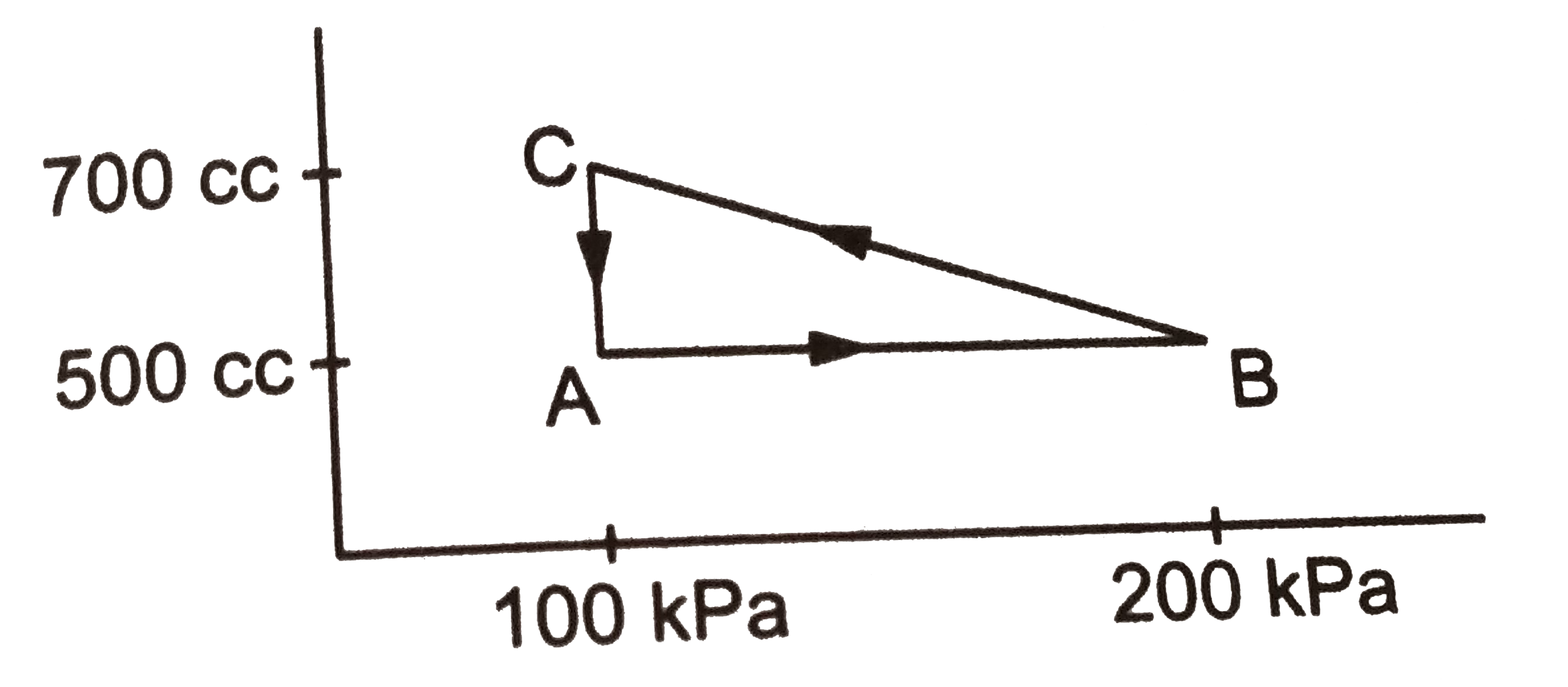
View SolutionA substance is taken through the process abc as shown in fig, if the internal energy of the substance increase by 5000 J and a heat of 2625 cal is given to the system, calculate the value of J.
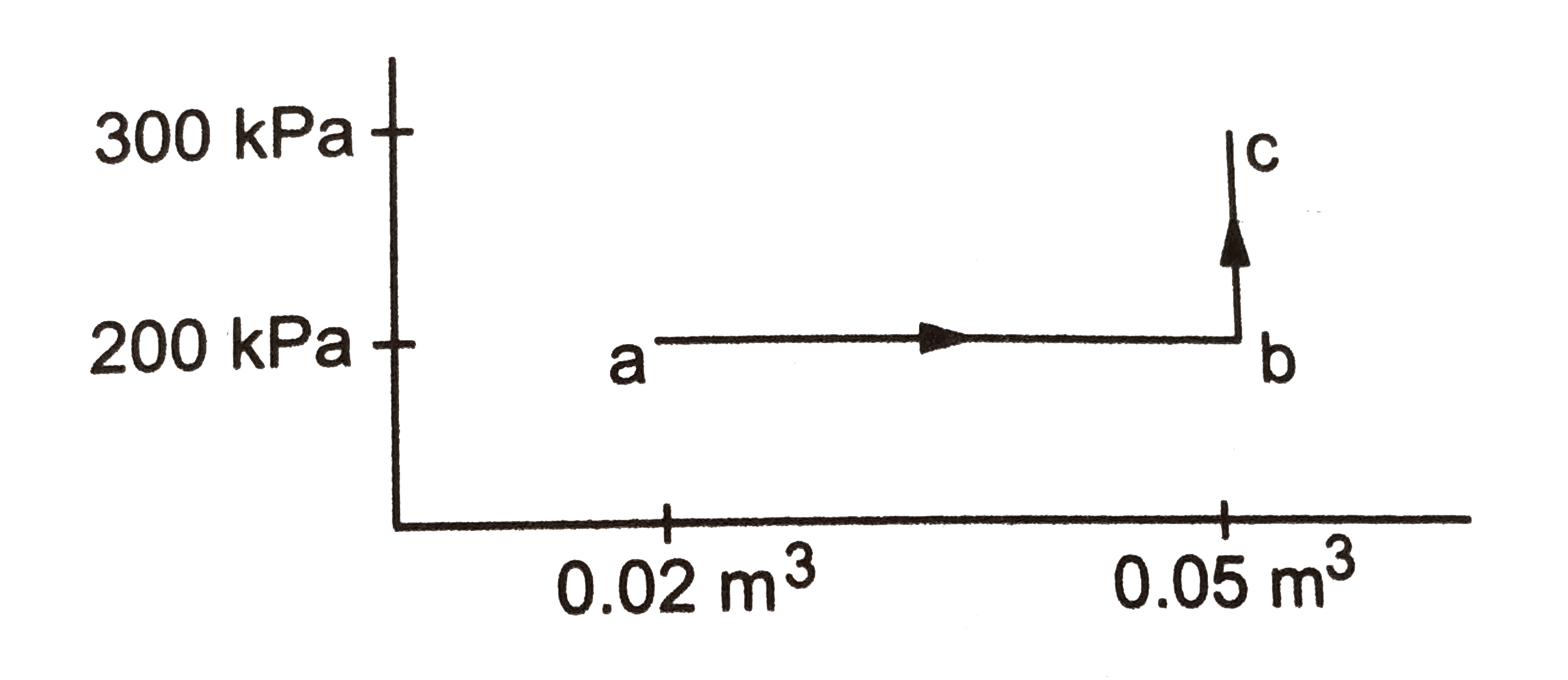
View SolutionA gas is taken along the path AB as shown in fig, if 70 cal of heat is extracted from the gas in the process, calculate the change in the internal energy of the system.
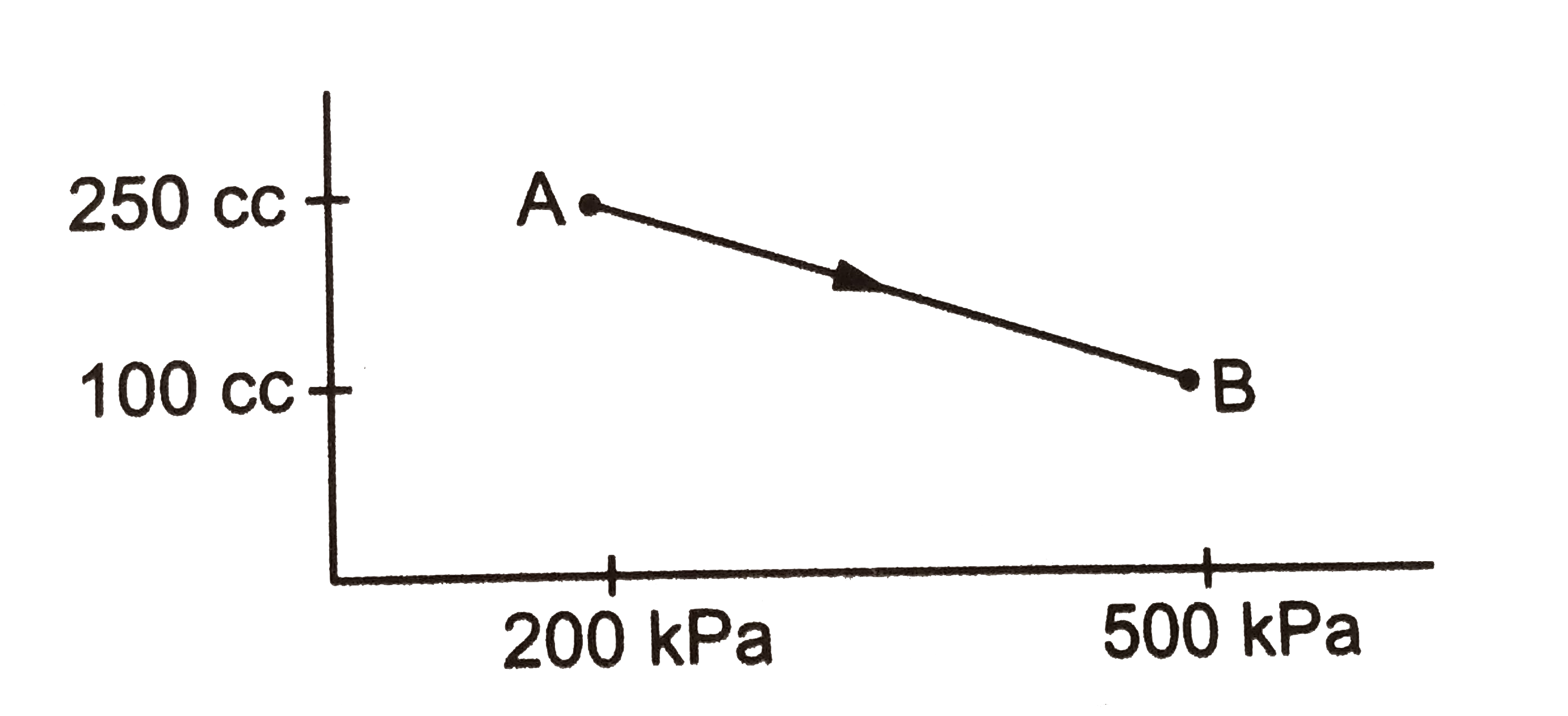
View SolutionThe internal energy of a gas is given by `U=1.5pV`. It expands from `100 cm^(3) to 200 cm^(3)` against a constant pressure of `1.0xx10^(5)` Pa. calculate the heat absorbed by the gas in the process.
View SolutionA gas is enclosed in a cylindrical vessel fitted with a frictionless piston.the gas is slowly heated for some time. During the process, 10 J of heat is supplied and the piston is found to move out 10cm. Find the increase in the internal energy of the gas, the area of cross section of the cylinder=`4 cm^(2)` and the atmospheric pressure `=100 kPa.`
View SolutionA gas is initially at a pressure of 100 kPa and its volume is `2.0 m^(3)`. Its pressure is kept constant and the volume is changed from `2.0 m^(3) to 2.5^(3)`. Its volume is now kept constant and the pressure is increased from 100 kPa to 200 kPa. The gas is brought back to its initial state, the pressure varying linearly with its volume. (a) whether the heat is supplied to or exterted from the gas in the complete cycle ? (b) how much heat was supplied or extracted ?
View SolutionConsider the cyclic process ABCA, shown in fig, performed on a sample of 2.0 mol if an ideal gas. A total of 1200 J if heat is withdrawn from the sample in the process. Find the work done by the gas during the part BC.
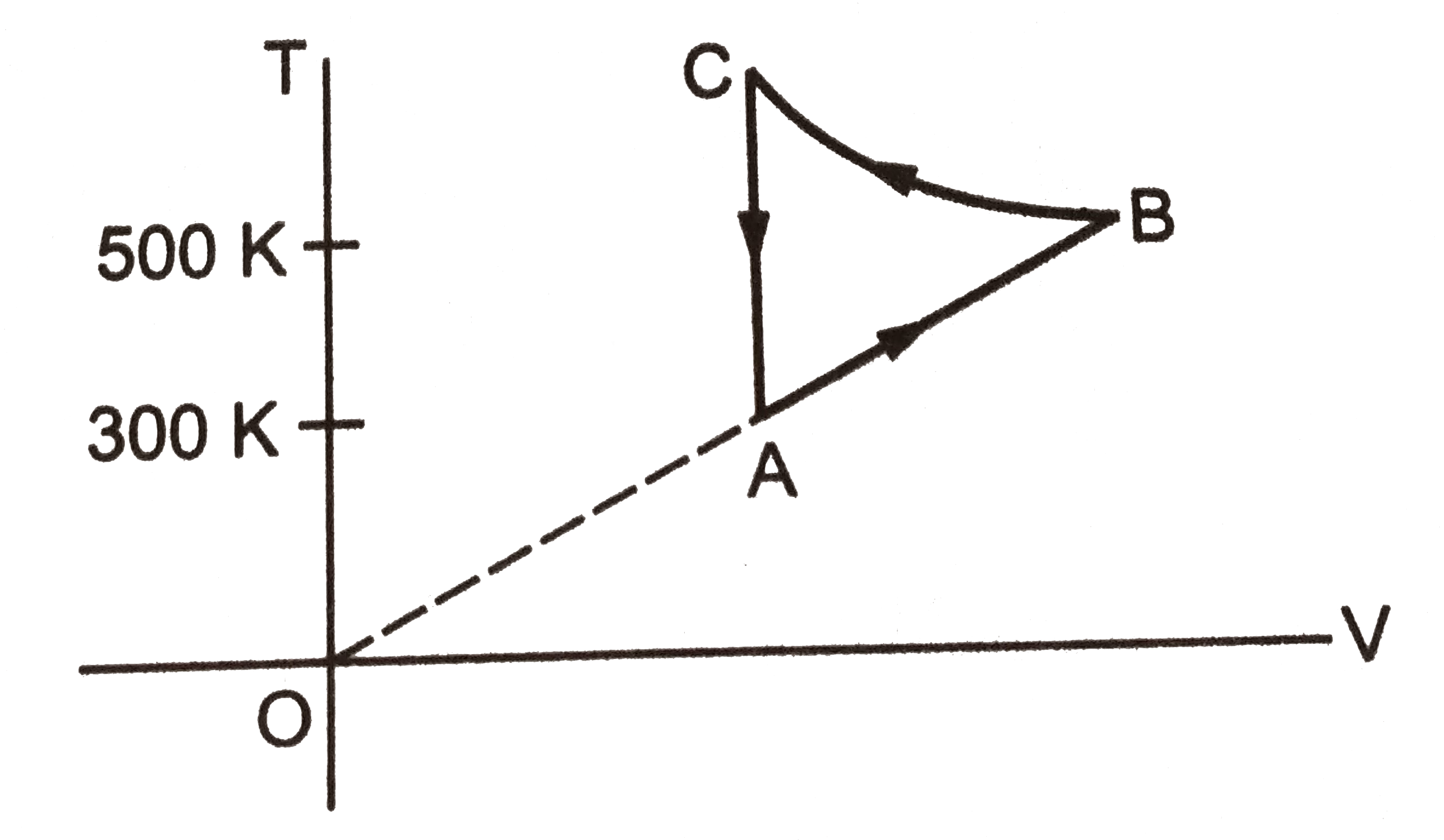
View SolutionFig shows the variation in the internal energy U with the volume V of 2.0 mol of an ideal gas in a cyclic process abcda. The temperatures of the gas at b and c are 500 K and 300 K respectively. Calculate the heat absorbed by the gas during the process.
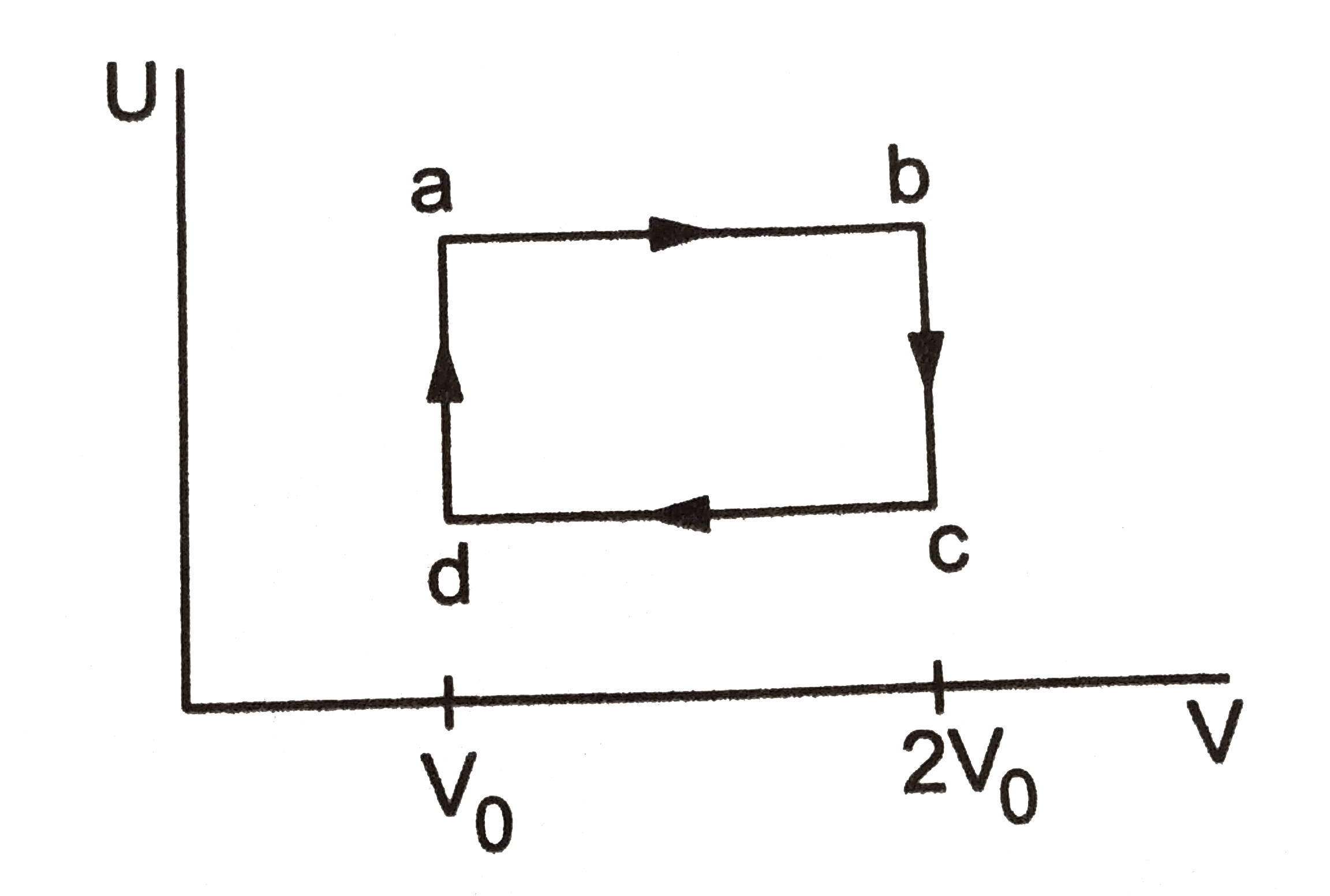
View SolutionFind the change in the internal energy of 2 kg of water as it heated from `0^(0)C to 4^(0)C`. The specific heat capacity of water is `4200 J kg^(-1) K^(-1)` and its densities at `0^(0)C` and `4^(0)C` are `999.9 kg m^(-3)` and `1000 kg m^(-3)` respectively. atmospheric pressure `=10^(5)` Pa.
View SolutionCalculate the increase in the internal energy of 10 g of water when it is heated from `0^(0)C to 100^(0)C` and converted into steam at 100 kPa. The density of steam `=0.6 kg m^(-3)` specific heat capacity of water `=4200 J kg^(-1 ^(0)C^(-3)` latent heat of vaporization of water `=2.25xx10^(6) J kg^(-1)`
View SolutionFig shows a cylindrical tube of volume V with adiabatic walls containing an ideal gas. The internal energy of this ideal gas is given by 1.5nRT. The tube is divided into two equal parts by a fixed diathermic wall. Initially, the pressure and the temperature are `p_(1), T_(1)` on the left and `p_(2), T_(2)` on the right. the system is left for sufficient time so that the temperature becomes equal on the two sides. (a) how much work has been done by the gas on the left part ? (b) find the final pressures on the two sides. (c ) find the final equilibrium temperature. (d) how much heat has flown from the gas on the right to the gas on the left ?

View SolutionAn adiabatic vessel of total volume V is divided into two equal parts by a conducting separator. The separator is fixed in this position. The part on the left contains one mole of an ideal gas `(U=1.5 nRT)` and the part on the right contains two moles of the same gas. initially, the pressure on each side is p. the system is left for sufficient time so that a steady state is reached. find (a) the work done by the gas in the left part during the process, (b) the temperature on the two sides in the beginning, (c ) the final common temperature reached by the gases, (d) the heat given to the gas in the right part and (e) the increase in the internal energy of the gas in the left part.
View SolutionShould the internal energy of a system necessarily increase if heat is added to it?
View SolutionShould the internal energy of a system necessarily increase if its tempreture is increased?
View SolutionA cylinder containing a gas is lifted from the first floor to the second floor.
(a) What is the amount of work done on the gas?
(b) What is the amount of work done by the gas?
(c) Is the internal energy of the gas increased ?
(d) Is the temperature of the gas increased?
View SolutionA force `F` is applied on a block of mass `M`. The block is displaced through a distance `d` in the direction of the force. What is the work done by the force on the block? Does the internal energy change because of this work?
View SolutionThe outer surface of a cylinder containing a gas is rubbed vigorously by a polishing machine. The cylinder and its gas become warm.is the energy transferred to the gas heat or work?
View SolutionWhen we rub our hands they become warm. Have we supplied heat to the hands?
View SolutionA closed bottle contains some liquid. The bottle is shaken vigorously for `5` minutes. It is found that the temperature of the liquid is increased. Is heat transferred of the liquid? Is work done on the liquid? Neglect expansion on heating.
View SolutionThe final volume of a system is equal to the initial volume in a certain process. Is the work done by the system necessarily zero? Is it necessarily nonzero?
View SolutionCan work be done by a system without changing its volume?
View SolutionAn ideal gas is pumped into a rigid container having diathermic walls so that the temperature remains constant. In a certain time interval, the pressure in the container is doubled. Is the internal energy of the contains of the container also doubled in the interval?
View SolutionWhen a tyre bursts, the air coming out is cooler than the surrounding air. Explain.
View SolutionWhen we heat an object, it expands. Is work done by the object in this process? Is heat given to the object equal to the increase in its internal energy?
View SolutionWhen we stir a liquid vigorously, it becomes warm. Is it a reversible process?
View SolutionWhat should be the condition for the efficiency of a carnot engine to be equal to `1`?
View SolutionWhen an object cools down, heat is withdrawn from it. Does the entropy of the object decrease in this process? If yes, is it a violation of the second law of thermodynamics stated in terms of increase in entropy?
View Solution
All Questions questions and complete solutions for chapter LAWS OF THERMODYNAMICS of HC VERMA PHYSICS (ENGLISH) of Class 11